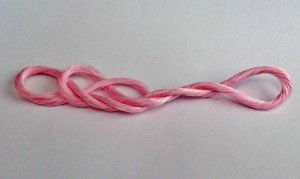
The “red silk of fate” is made by twisting together two kinds of silk threads, one containing oxytocin and the other containing red pigment.(Courtesy of National Agriculture and Food Research Organization)
A project is under way to realize the East Asian mythology that the gods tie an invisible “red string of fate” between those who are destined to fall in love.
Sputniko!, a mathematician-turned-artist and an assistant professor of the Massachusetts Institute of Technology’s Media Lab in the United States, approached Hideki Sezutsu, head of the Transgenic Silkworm Research Unit at the National Agriculture and Food Research Organization, with an idea to spin the mythical string by inserting genes that produce oxytocin, widely referred to as the love hormone, into silkworm eggs.

A screen shot from the film “Red Silk of Fate – Tamaki’s Crush” shows silkworms which are genetically modified to spin threads containing oxytocin.(Courtesy of Sputniko!)
The project, which utilizes genetically engineered silkworms developed in Japan, is also aimed at giving consumers, many of whom express reluctance toward genetic engineering, the opportunity to think about the technology.
The scientists have already succeeded in spinning the genetically modified silk which includes oxytocin, the hormone that increases when a couple in love hug each other. They also managed to create threads from another genetically modified silkworm that contains red pigment protein taken from corals. They twisted the two types of silk together to create the “red silk of fate.”
In order to promote the project among the general public, Sputniko! released a short film titled “Red Silk of Fate – Tamaki’s Crush” at the Setouchi Triennale 2016, an international art festival held on the islands in the Seto Inland Sea. The film depicts a young female engineer who creates her own red silk of fate to win the heart of a man she has a crush on.

A screen shot from the film “Red Silk of Fate – Tamaki’s Crush” shows a woman wearing red dress made from genetically modified silk spreading her arms.(Courtesy of Sputniko!)
However, oxytocin is said to work as the love hormone only when it is taken into the body. “To tell you the truth, you can’t expect much love-related effect only by wearing a clothing made of this silk,” Sezutsu said.
The research team believes the real purpose of the project is to let people think about the desirability of genetic engineering. Since creating silk from genetically modified silkworms is yet to obtain government approval, Sezutsu says the red silk of fate will not be put to practical use any time soon.
On the other hand, genetically modified silkworms have already been used to manufacture ingredients for drugs and cosmetics, and to develop anticancer drugs and medicines to treat mastitis in dairy cows.
Nevertheless, there remain considerable public skepticism and resistance toward genetic modification. Because it would be difficult to spread the technology without social acceptance, Sputniko! says the team hopes to use the product to pose a question to the public on how they perceive genetic engineering.

